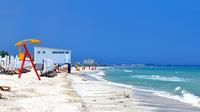Private Tour of the Black Sea Coast - A journey from Romania to Bulgaria
Bucharest, Romania
Trip Type: Overnight Tours
Duration: 2 days
A two-days trip meant to trace the Dacian and Roman origins of the Romanian people (Tropaeum Traiani from Adamclisi), to catch a glimpse of the Romanian spiritual life at Saint Andrew Monastery and to admire Queen Mary of Romania’s castle in Balchik (Bulgaria). The second day of the journey is dedicated to the discovery of the Bulgarian Black Sea Coast, with visits to Caliacra, Golden Sands resort and Varna.
More About This Activity All Overnight Tours →
A two-days trip meant to trace the Dacian and Roman origins of the Romanian people (Tropaeum Traiani from Adamclisi), to catch a glimpse of the Romanian spiritual life at Saint Andrew Monastery and to admire Queen Mary of Romania’s castle in Balchik (Bulgaria). The second day of the journey is dedicated to the discovery of the Bulgarian Black Sea Coast, with visits to Caliacra, Golden Sands resort and Varna.Day 1: Bucharest, Calarasi, cross the Danube River with the ferry, Dervent Monastery, Sf. Andrew Cave Monastery, Adamclisi andTropaeum Traiani,, Eforie (late lunch), Vama Veche, Balchik. (10 hours)
Day 2: Balchik – visits to Bothanical Garden and the Royal Residence of Queen Mary of Romania, Caliacra, Golden Sands, Varna (lunch), Ruse, Bucharest. (9 hours)
The Roman complex Tropaeum Traiani from Adamclisi was built in 109 by the well-known architect Apollodor of Damascus, to celebrate the victory of Rome over Dacia, a historical “stone document“, similar to Trajan’s Column in Rome.
Saint Andrew’s Cave was discovered in 1918, by a Romanian lawyer, who dreamt about it one night and went looking for it, just to find the cave in an advanced state of degradation.
The restoration of the cave began only in 1990, as well as the construction of the monastery.
The cave shelters the icon of Saint Andrew, the apostle who Christianized the people living at the North of Danube. The old church hosts the relics of the saint. A cross in the shape of ‘X’ , with part of a finger belonging to the saint, is kept in front of the altar.
The monastery is known as “The Bethleem of Romanian people”, as thousands of pilgrims come each year to Saint Andrew’s Cave.
Born in Kent, Great Britain, Queen Mary of Romania confessed that Balchik meant a return to her first love, the sea. She loved that place so much that in her last will stated that her heart should be put to rest at Balchik, in the castle, by the waves of the Black Sea. Unfortunately, Romania lost that piece of land to Bulgaria and the box containing the queen’s heart was moved to Bran Castle and then on to The National Museum of History. The official name of the castle was “Quiet Nest Palace”.
In Balchik, the beach is not dominated by an imposing castle or sumptuous buildings – Queen Mary had never been a megalomaniac person. Instead, it is the animation of space and the human common scale of the villas that are impressive.
The most wonderful place on Balchik domain is “the divine garden”, that the Turks renamed “the Garden of Allah”. The model for this garden, arranged in only four years, was the Biblical Garden of Eden. To fit the biblical description, an artificial river was built, with four arms.
Day 2: Balchik – visits to Bothanical Garden and the Royal Residence of Queen Mary of Romania, Caliacra, Golden Sands, Varna (lunch), Ruse, Bucharest. (9 hours)
The Roman complex Tropaeum Traiani from Adamclisi was built in 109 by the well-known architect Apollodor of Damascus, to celebrate the victory of Rome over Dacia, a historical “stone document“, similar to Trajan’s Column in Rome.
Saint Andrew’s Cave was discovered in 1918, by a Romanian lawyer, who dreamt about it one night and went looking for it, just to find the cave in an advanced state of degradation.
The restoration of the cave began only in 1990, as well as the construction of the monastery.
The cave shelters the icon of Saint Andrew, the apostle who Christianized the people living at the North of Danube. The old church hosts the relics of the saint. A cross in the shape of ‘X’ , with part of a finger belonging to the saint, is kept in front of the altar.
The monastery is known as “The Bethleem of Romanian people”, as thousands of pilgrims come each year to Saint Andrew’s Cave.
Born in Kent, Great Britain, Queen Mary of Romania confessed that Balchik meant a return to her first love, the sea. She loved that place so much that in her last will stated that her heart should be put to rest at Balchik, in the castle, by the waves of the Black Sea. Unfortunately, Romania lost that piece of land to Bulgaria and the box containing the queen’s heart was moved to Bran Castle and then on to The National Museum of History. The official name of the castle was “Quiet Nest Palace”.
In Balchik, the beach is not dominated by an imposing castle or sumptuous buildings – Queen Mary had never been a megalomaniac person. Instead, it is the animation of space and the human common scale of the villas that are impressive.
The most wonderful place on Balchik domain is “the divine garden”, that the Turks renamed “the Garden of Allah”. The model for this garden, arranged in only four years, was the Biblical Garden of Eden. To fit the biblical description, an artificial river was built, with four arms.
Included Services: 1 night accomodation in a 3 or 4 stars hotel, transport, certified international guide, late lunch in Eforie and lunch in Varna
« Go Back

